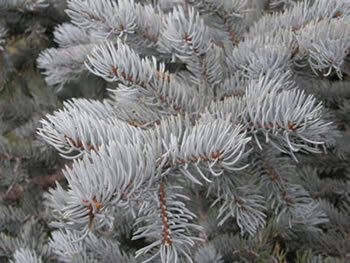|
__ |
|
Conifers are trees that bear cones and have needlelike or scalelike leaves.They belong to the group of plants called Coniferae. There are over 600 species around the world including over 200 in North America. The wood of conifers is known as softwood. |
|
The taiga or Boreal Forest is world’s largest land biome and is mostly made up of conifers especially pines, spruces and larches. It makes up almost a third of the world’s forest and covers a huge area of the Northern Hemisphere’s cool temperate region. |
| |
|
|
|
|
|
Most conifers have needlelike leaves. These conifers include firs, pines, and spruces such as this Colorado Blue Spruce, Picea pungens. |
|
The needlelike leaves help conifers survive in harsh, cold climate. These leaves are tough and covered with a waxy outer coast called a cuticle. |
| |
|
|
|
|
|
Conifers such as cedars, cypresses and junipers have scalelike leaves, like the Western Redcedar, Thuja plicata. |
|
Conifers produce their seeds in cones. The scales on the cone are called bracts and the seeds develop between them. |
| |
|
|
|
|
|
Cones are soft and green when they first form, turning brown and hardening as they ripen. Usually they remain upright on the branch until they are ripe. |
|
Conifers have male and female cones. The male cones release pollen grains which are blown by the wind. If the pollen lands on the female cones, it fertilizes the female eggs. |
| |
|
|
|
|
|
The female cones open up after one or two years, when the seeds have matured. |
|
After the seeds have been released from the cone, it drops to the ground. |
| | |
|
|
|
|
|
The cones of most conifers turn over when they ripen, so that the seeds can fall out. Seeds are dispersed by the wind and sometimes by birds. |
|
Throughout the winter, the long, hanging cones like those of spruces and pines remain on the tree. In the spring the seeds are released. |
| |
|
|
|
|
|
The cones of cedars like this Western Redcedar, Thuja plicata, of the Pacific Northwest remain upright. The bracts drop away to release the seeds. |
|
The Utah Juniper, Juniperus osteosperma, appears to bear small berries but they are not fruit at all. In reality, they are specially adapted cones. |
|
|
|
|
|
|
The bark of the Utah Juniper is often gnarled and and almost dead looking. It especially adapted to the harsh conditions of the desert. |
|
The Larch or Tamarack is the only conifer to lose its leaves. In the fall the needles turn into brilliant golden-yellow colours. |
| |
|
|
|
|
|
Although classified as evergreens, most conifers actually shed their leaves that are two or more years old. |
|
If you find a conifer with needles growing in groups, it’s a pine tree. They can be in groups of two, five or three like the Ponderosa Pine, Pinus ponderosa.
|
| |
|
|
|
|
|
Pines make up the largest family on conifers. There are 36 native species of pine in North America.
|
|
The Ponderosa Pine has a great ability to survive fire. Interestingly, its tough bark smells like butterscotch! |
| |
|
|
|
|
|
The Bristlecone Pine, Pinus longaeva, has needles in groups of five that look like a small brush, giving it its common name.
|
|
The Bristlecone Pine is a long-growing tree found in the harsh regions of the southwestern United States. Some are over 4,000 years old. |
| |
|
|
|
|
|
If the needles of a conifer are singular and flat, the tree is a fir, like this Balsam Fir, Abies balsamea. |
|
If you touch the needles of a fir tree, they will not prick you. Some people say “firs are friendly” to help remember the difference between firs, spruces and pines.
|
| |
|
|
|
|
|
If the needles are singular and 4-sided, the tree is a spruce. You can roll the needles between your fingers but if you touch the branch of a spruce it will tend to prick you gently. |
|
Spruces belong to the genus Picea and there are some 35 species in the world. They are generally tall trees and grow in a cone form, like this Colorado Blue Spruce. The conical shape helps the trees shed snow. |
| |
|
|
















